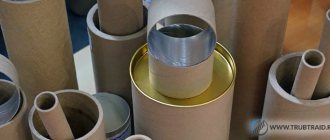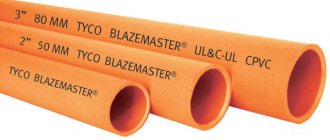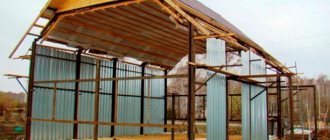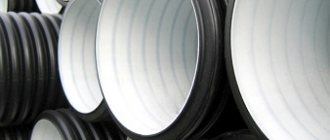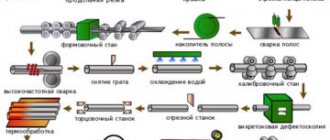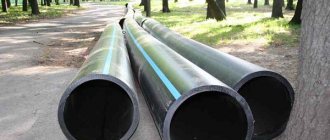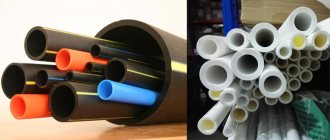Hot-deformed or cold-deformed steel pipe is considered the highest quality metal pipe, which allows the product to be used in various fields of construction and so on. What is the difference between cold-formed and hot-formed pipes? Where are these types of pipes used? What nuances exist when installing this or that type of pipe? Answers to these and many other questions can be obtained by reading this article.
Pipes made of steel
Hot-cold rolled pipes - differences
Cold-rolled and hot-formed steel pipes are used all over the world.
Accordingly, there are two methods for making pipes: cold-rolled and hot-rolled. Some people prefer hot-rolled products, while others prefer cold-rolled pipes according to GOST 8734. Thanks to special production technology, cold-rolled pipes have a number of advantages over their hot-rolled counterparts. Therefore, the areas of application of cold-rolled steel pipes are very diverse.
But to be completely honest, each of these production technologies has its own advantages and disadvantages. Therefore, you need to know how to distinguish a hot-rolled pipe from a cold-rolled pipe, since the production technology of these two types of steel products is completely different.
Mounting options
The choice of installation is based on the functions of the route being laid. When a tight and durable connection is required, welding is preferred. In household pipelines, the choice is often made to use fittings as pipe fastenings.
The fitting connection of pipes involves a number of stages:
- Applying threads to the previously cleaned edge of the pipe;
- Using special threads as a reinforcer;
- Connection with fitting.
Both hot-deformed and cold-deformed pipelines and mains last more than 50 years. They are reliable, easy to repair and withstand changes in the external environment.
Submit your application
So what is the difference between a hot-rolled pipe and a cold-rolled pipe?
The main difference is that during the production of cold-rolled products, steel sheets are subjected to mechanical pressure. This technique is used in the manufacture of mild steel pipes.
Since the proportion of carbon in such blanks is very small, during the production of products such cold-rolled pipes can be given the necessary qualities.
Cold-rolled GOST pipes are most often made from steel blanks of grades St10, St20, St25.
With this production, the final cold-rolled products are almost perfectly smooth, which is extremely important when working with liquids containing various impurities, since there is practically no sediment on the walls.
The conclusion suggests itself that the main difference between hot-rolled and cold-rolled pipes is their appearance, which is almost always free of defects.
The cost of hot-rolled products is significantly less compared to cold-rolled pipes. But this positive property is compensated by the quality of the surface, which wants to be a little better.
Besides:
- Hot rolled products are less deformed. Therefore, the best place for their installation is engineering systems without complex structures, since they can be damaged when transporting media under high pressure;
- more resistant to corrosion processes, which has a positive effect on service life.
Application areas of seamless hot-rolled products
It is impossible to imagine our life without large and small pipelines. Pipes surround us on all sides: gas pipelines, heating systems, water supply, sewerage, ventilation, chimneys - all provide us with comfortable civilized living. The further into civilization, the more pipes surround us.
Pipelines ensure the existence of every area of our life:
- Industry.
- Agriculture.
- Mining industry.
- Power plants.
- Oil and gas industry; giant oil and gas pipelines.
- In all types of transport, aircraft and shipbuilding.
- When constructing all kinds of improvement items - furniture, home appliances, decorative structures.
Special mention should be made about the use of pipes in construction:
- Metal structures are used in the construction of residential buildings, production workshops and technical structures, and public buildings.
- During the construction of huge unique structures - bridges, airports, train stations, stadiums, shopping and entertainment centers, office buildings.
- In the design of cities there are all kinds of fences, canopies, pavilions, playgrounds, billboards, signs, benches.
- In private construction - all kinds of structures, canopies, fences, gratings, enclosures.
GOSTs and cost
The technical characteristics of steel products, the list of which is recorded in GOSTs, depend on the manufacturing method. Therefore, everyone who deals with pipes should be well acquainted with these documents and take into account the recommendations during their installation and operation. Today there are a number of regulatory documents on pipes.
The most popular are:
- rectangular profile pipes made of cold-rolled metal, the range of which is fully described in GOST 8645-68. In particular, this GOST provides for the production of hot-rolled profiles, as well as cold-rolled seamless rectangular pipes. By the way, the latest version of the product is the most durable and reliable. Their significant “minus” is their relatively high cost.
- Seamless cold-rolled pipes regulated by GOST 8734-75. Round seamless cold-rolled steel pipes fall under this state standard. Their production is very similar to the technological process for manufacturing hot-rolled products. But there is also a significant difference, which is that after passing the firmware through the press, the product is subjected to water cooling.
- GOST 10707 80. It lists technical standards for cold-rolled electric-welded pipes with varying degrees of accuracy, which can be of regular, increased, precision types. Products are produced from carbon steel grades with a cross section of 5-110 mm.
- GOST 8639-82. This standard lays out the requirements for profile square steel seamless hot- and cold-rolled, electric-welded cold-rolled pipes, as well as for electric-welded hot-calibrated products. They are produced with wall thicknesses from 0.8 mm to 14 mm with outer diameters from 10 to 180 mm. Their length can be unmeasured, measured and multiple of measured.
- GOST 10706-76 (91). Refers to electric-welded straight-seam steel pipes for general purposes. The document contains requirements for pipes with a diameter of 426-1620 mm.
- GOST 30732-2006. This state standard was approved in 2006. It characterizes steel products with polyurethane foam thermal insulation and a polyethylene shell. Sometimes, instead of polyethylene, you can find protection in the form of a steel coating. Such products are used when it is necessary to lay underground heating networks. According to the document, in such products it is allowed to use coolant with a temperature of up to + 140⁰С at a pressure not higher than 1600 kPa.
What experts advise to pay attention to when choosing VGP
For all of us, who, in reality, are the end consumers of natural household gas and water (hot, cold), the quality and choice of VGP certainly represent and acquire a specific meaning. In particular, knowledge of the basic characteristics and dimensions, the ability to choose the right material of this kind can be useful in private construction, as well as when arranging gas removal and water supply on a separate site or dacha. Steel and galvanized VGP pipes are needed here to solve specific problems set by the project. And without understanding what a VGP pipe is, it is impossible to make the choice properly.
Of course, such a responsible job is most likely best left to specialists. But in order to correctly select and install, use wire material and use it for its intended purpose, it is important for everyone to know the classification of these products. These general criteria are specified in GOSTs, which are given above in the article. But what should first of all be paid attention to by someone who is planning to build or supply gas (water) to the site? An important and primary criterion for the range of VGP pipes will be: the material of manufacture and methods of processing this material. You already know that, depending on these characteristics, there are:
- A pipe made of metal, where the surface is not protected by anything;
- A pipe whose surface has undergone a galvanizing process.
Galvanized water and gas pipes will last longer
At the same time, the product, on the surface of which a zinc layer is applied, will be visually distinguishable from ordinary ferrous metal ones (make sure of this by comparing photographs of both wire materials). This surface treatment of VGP is done in order to reliably protect the material from aggressive environmental influences and possible mechanical damage. The VGP pipe coated with a thin zinc layer, thanks to the properties of this metal, perfectly resists rust and moisture, can be used most efficiently and successfully even in the most difficult natural environmental conditions, for a long time - a long period of time without repairs or replacements.
VGP from ferrous metals
Also, the most important parameter of VGP, regardless of whether they have been galvanized or not, is the geometric data: 1) nominal diameter - it is usually designated as the abbreviation DU, 2) pipe wall thickness.
Table of pipe assortments available
Kinds
Steel
It is impossible to do without cold-rolled steel products either in industrial production or in everyday life. Highways assembled from such products transport liquids and gaseous media. Steel pipes can be used to reliably protect power and signal cables. The products are successfully used in aircraft and automobile construction, oil and gas, chemical industries, and for household purposes.
They differ:
- increased strength;
- reliability;
- ability to withstand internal and external pressures;
- long service life.
The “disadvantages” include the low ability to counteract various types of deposits, as well as corrosion processes.
According to production methods, steel pipes are:
- electric welded, which, in turn, are divided into straight- and spiral-welded, as well as profile and water-gas;
- seamless, which include hot- and cold-rolled.
In order to protect against corrosion, products are subjected to:
- hot or cold galvanizing;
- coating using extruded polyethylene, cement-sand and bitumen mixtures.
The price of cold-rolled seamless pipe depends on:
- conditional passage;
- outer diameter;
- wall thickness;
- steel grade and other technical parameters.
In addition, the cost is affected by the size of the purchase lot (wholesale or retail). Therefore, before you buy cold-rolled pipes, you need to know 100% what products and in what quantity you need.
Seamless
Seamless cold-rolled pipes according to GOST 8734 75 are a type of solid rolled metal, for the production of which special rolling machines are used.
The name says that this product has no seam. Therefore, they are used in conditions with possible increased mechanical, chemical, and thermal influences.
Depending on the production method, the pipe can be:
- seamless;
- hot rolled;
- cold rolled.
Such products have a number of advantages, among which the main ones are:
- increased strength;
- ability to withstand sudden changes in pressure and temperature;
- reliability;
- resistance to mechanical loads;
- resistance to the influence of environments of chemical origin.
You can buy seamless cold-rolled pipe in specialized or online stores.
Square
The construction of bridges, arches, columns, sports and retail premises, and other industrial and domestic buildings cannot be done without rectangular and square cold-rolled pipes. Enterprises engaged in the production of corrugated pipes use steel, copper, aluminum, brass, and other metals and alloys for these purposes.
For the construction of frames, hangars, billboards, furniture elements, stationary greenhouses and conservatories, and other metal structures, no one uses steel, aluminum or copper round drawn pipes, just as no one uses a cold-rolled profile product for installing water supply and heating systems.
Among the many square cold-rolled profile pipes we can highlight:
- trunk type profile. They are used as supporting elements to support large pipelines where there are areas with frequent sudden changes in pressure and temperature. As a rule, such designs are made to order;
- classic professional pipes. With their help, scaffolding and pipelines are constructed. They are indispensable in the construction of protective structures for cables; you cannot do without them if you need to build an irrigation system, a good wicket, gate or fence;
- chemically resistant rolled metal. Such products are used in the pharmaceutical, food, and chemical industries;
- machine-building professional pipes. Such rolled metal is an excellent material for the production of shafts, bearings, cylinders, and piston systems.
Round
The most extensive group of steel pipes, with a rather complex systematization, are round products. The method of production of a product determines its range.
Round cold-formed steel pipes can be:
- seamless. Their production is carried out according to a very similar scheme for the production of hot-deformed products. The difference is that during the production of cold-rolled seamless pipe, water is used to cool the workpiece. Such products are regulated by GOST 8734-75;
- straight-seam electric welded (GOST 10707-91). Products of large diameters are defined in GOST 52079-2003;
- electric welded spiral welded with diameters ranging from 114 mm to 1420 mm. This rolled metal product is used for the installation of oil and gas pipelines. The products are able to withstand pressures up to 9800 kPa at temperatures not lower than -60⁰С;
- gas and water pipes, which are defined by special GOST 3262-75. Usually they come in dimensional and unmeasured types with a length of 4 m to 12 m. In everyday life, thin-walled cold-rolled pipes with a wall thickness of 1.8 mm to 4 mm are used.
Profile
Profile pipes practically cannot be used as fittings for the installation of pipelines transporting liquid or gaseous media.
Rectangular or square parts have a low specific weight. Most often they are used to build frames and connecting parts of various buildings.
They differ:
- increased strength, and therefore reliability in operation;
- low cost compared to other types of fittings;
- ease of installation;
- efficiency;
- ability to withstand high temperature changes.
Retail premises, industrial and residential buildings, warehouses, sports facilities, towers - this is not a complete list of areas of use of profile structures. They are also successfully used in the auto and motorcycle industry, and the furniture industry (especially thin-walled versions).
Thin-walled
Architectural structures, furniture production, very light frames of advertising buildings, household structures - in these and other cases, the use of thin-walled pipes is observed.
They differ:
- strength and reliability;
- plasticity;
- lower cost compared to thick-walled analogues;
- breadth of application.
In addition, such products can easily be welded together, which is very important when installing pipelines.
Both round and profile analogues can be thin-walled. The price of thin-walled cold-rolled pipe depends on many factors. The required choice of a thin-walled product is determined by the scope of its application. When choosing a product you need to consider:
- length and diameter;
- wall thickness;
- steel grade.
Electric welded
Electric-welded pipes are usually used in the installation of water and gas pipelines, both inside and outside buildings.
With their help, a wide variety of rural, town and city main pipeline systems are built, varying in length and diameter. Accordingly, an entire industry has been created that provides the process of installation of electric-welded structures with various shut-off and connecting fittings in the form of flanges, stopcocks, valves, couplings, tees, adapters, elbows, valves, etc.
Not only pipelines are constructed using electric welded structures. They are used to make poles, supports, lighting masts, fences, gates, fences, and other household and industrial structures.
Copper
There is a slight difference in strength and temperature characteristics between steel and copper parts. But still, copper structures have a number of advantages. Drawn cold-rolled copper pipes (GOST 617-90) are characterized by the following properties:
- high anti-corrosion resistance. And if we take into account the increased strength of the connections, the service life of copper parts is much longer than that of their steel counterparts;
- low material consumption. In the production of steel products, the wall thickness is much greater, since it is also necessary to take into account the necessary thickness margin for corrosion processes;
- perfectly smooth internal and external surface. And since there is practically no sediment, tubes of very small diameters can be used;
- when connecting parts, they use the most modern methods, which is technologically important during installation or repair work;
- high reliability of fittings and connecting elements.
Today, Finnish cold-rolled copper pipe is quite popular among consumers, which is usually sold in coils with a total length of 50 m.
Briefly about VGP
All that remains is to clarify the very concept of a VGP pipe: what it is, and how the product differs from other steel pipes. In principle, a water and gas pipe is a special case, one of the widely used varieties, of electric-welded metal, produced in accordance with GOST 3262 standards. Its main difference from its “brothers” is the reinforced seam, a feature that allows it to withstand greater pressure than other materials. In addition, the VGP pipe is distinguished by increased anti-corrosion qualities, which is also an important factor in the technical operating conditions.
For water and gas
Where can I buy
It is not difficult to buy pipes - all large construction hypermarkets and large markets have a large assortment of pipe products. There are also many manufacturers, and each region has its own. You will have to select pipes visually and based on the presence of a certificate. However, even before purchasing, it is worth assessing the future structure or system - in home construction, high strength and tightness are not always required.
For a fence, enclosure, heating system or fencing, you can choose pipes of any quality; when used for a canopy or roofing, you should choose seamless products. If the structures will be loaded or responsible, be sure to request a quality certificate from the seller. But also look with your eyes to see if there is a lot of rust, if the wall thickness corresponds to the declared one, if there is a strong bend or even waviness, or even holes in the walls.


